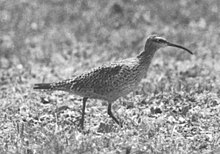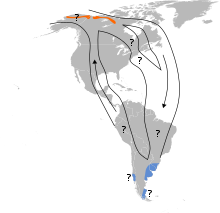Eskimo curlew
| Eskimo curlew | |
|---|---|

| |
| One of four known photographs of a living Eskimo curlew, taken by Don Bleitz on Galveston Island in 1962 | |
| Scientific classification | |
| Domain: | Eukaryota |
| Kingdom: | Animalia |
| Phylum: | Chordata |
| Class: | Aves |
| Order: | Charadriiformes |
| Family: | Scolopacidae |
| Genus: | Numenius |
| Species: | N. borealis
|
| Binomial name | |
| Numenius borealis (Forster, 1772)
| |

| |
The Eskimo curlew (Numenius borealis), also known as northern curlew, is a species of

Taxonomy

The Eskimo curlew is one of eight species of
The species was described by
This species has many common names. It has been named the prairie pigeon, fute, little curlew, doe-bird, and doughbird. These last two names come from its fatness during early migration south.[8]
Description
Eskimo curlews are small curlews, about 30 centimeters in length,[9] weighing approximately 360 g, and having a wingspan of 70 cm.[10] Adults have long dark greyish legs and a long bill curved slightly downward. The upperparts are mottled brown and the underparts are light brown. They show cinnamon wing linings in flight. They are similar in appearance to the Hudsonian curlew, the American subspecies of the whimbrel, but smaller in size.
In the field, the only certain way to distinguish the Eskimo curlew is confirmation of its unbarred undersides of the
The Eskimo curlew forms a species pair with the Asian little curlew (Numenius minutus), but is slightly larger, longer-winged, shorter legged, and warmer in plumage tone than its Asian relative.
Distribution and habitat
The Eskimo curlew is a New World bird. Members of this species bred on the tundra of western Arctic Canada and Alaska.
Eskimo curlews migrated to the Pampas of Argentina in the late summer and returned in February.[9] They used to be very rare vagrants to western Europe, but there have been no recent records. In Britain, there are four records, all from the nineteenth century.[13]
A comparison of dates and migratory patterns has led some to conjecture that Eskimo curlews and
Ecology and behavior

Diet
Eskimo curlews picked up food by sight, as well as feeding by probing. They ate mostly berries while on the fall migration in Canada. During the rest of their migration and on the breeding grounds, they ate insects. Snails and other invertebrates (including the extinct Rocky Mountain locust)[15] also were part of their diet during migration.
Reproduction
Nesting probably occurred in June. Nests were in open areas on the ground and are difficult to find. They were made of wisps of dried grass or leaves. The eggs were green with brown splotches.[8]
The specific
Probable extinction

At one time, the Eskimo curlew may have been one of the most numerous shorebirds in North America, with a population in the millions. As many as 2 million birds per year were killed near the end of the nineteenth century. The last confirmed sightings were in 1962 on Galveston Island, Texas (where it was photographed) and on Barbados in 1963 (where a specimen was collected). There was a reliable report of 23 birds in Texas in 1981, and a few dozen additional unconfirmed reports from scattered locales (the Northwest Territories, Texas, Ontario, Manitoba, Massachusetts, Alaska, Nova Scotia, Saskatchewan, Argentina, Guatemala, Labrador, New Jersey, and North Carolina) between 1964 and 2006.[17][18][19] No confirmed record of this species has been reported in South America since 1939. It has been suggested that the species not be treated as extinct until all possible remaining habitats have been surveyed and incidental sightings have ceased, and an assessment of critically endangered (possibly extinct) be adopted in the meantime.[1] Full details on all sightings up to 1986 are included in the online edition of Eskimo Curlew: A Vanishing Species?[20]
This species is fully protected in Argentina, Brazil, Canada, Mexico, and the United States. Hunting has been outlawed since around 1916.
In popular culture

The plight of this bird inspired the novel (and subsequent Emmy Award-winning 1972 ABC Afterschool Special) Last of the Curlews.
The Esquimaux Curlew appears as
References
- ^ . Retrieved 12 November 2021.
- ^ "Appendices | CITES". cites.org. Retrieved 2022-01-14.
- ^ "Numenius borealis. NatureServe Explorer 2.0".
- American Ornithologists' Union. "A classification of the bird species of South America Part 02". Archived from the originalon 2008-04-12. Retrieved 2008-01-12.
- ^ "Coraciiformes". zoonomen.net. Retrieved 2007-12-21.
- ISBN 0-394-46651-9.
- ^ Gollop, J.B.; Barry, T.W.; Iverson, E.H. (1986). "A Curlew By Many Other Names". Eskimo Curlew A Vanishing Species?. Nature Saskatchewan. Retrieved 2008-01-12.
- ^ ISBN 0-394-46651-9.
- ^ ISBN 0-06-055804-0.
- ^ "BTO BirdFacts | Eskimo Curlew". app.bto.org. 16 July 2010. Retrieved 2020-09-30.
- JSTOR 4076883.
- ^ Gollop, J.B., ed. (1986). Eskimo Curlew: A Vanishing Species?. Nature Saskatchewan Saskatchewan Natural History Society.
- ^ Melling, Tim (2010). "The Eskimo Curlew in Britain". British Birds. 103 (2): 80–92.
- ISBN 0-395-77017-3.
- ^ Gill, R. E.; Canevari, P.; Iversen, E. H. 1998. Eskimo Curlew (Numenius borealis). In: Poole, A.; Gill, F. (ed.), The birds of North America, No. 347, pp. 1-28. The Academy of Natural Sciences and The American Ornithologists' Union, Philadelphia and Washington DC.
- ^ Gollop, J.B.; Barry, T.W.; Iverson, E.H. (1986). "Life History – Briefly Stated". Eskimo Curlew A Vanishing Species?. Nature Saskatchewan. Archived from the original on 2008-07-19. Retrieved 2008-01-12.
- ^ "Eskimo Curlew Species Profile". Alaska Department of Fish and Game. Retrieved 2020-10-07.
- ^ "COSEWIC Assessment and Status Report on the Eskimo Curlew Numenius borealis in Canada" (PDF). Committee on the Status of Endangered Wildlife in Canada. Retrieved 2020-10-07.
- ^ Hoffman, Randy (2 October 2018). "A birdwatcher at Peggy's Cove, Nova Scotia, reports seeing a species presumed extinct: an Eskimo Curlew". BirdWatching.
- ^ "Eskimo Curlew: A Vanishing Species?". Nature Saskatchewan. Archived from the original on 29 May 2014. Retrieved 2022-01-26.
Further reading
- del Hoyo, J.; Elliott, A. & Sargatal, J. (editors) (1996): ISBN 84-87334-22-9.
- National Geographic Society (2002): Field Guide to the Birds of North America. National Geographic, Washington, D.C. ISBN 0-7922-6877-6.

